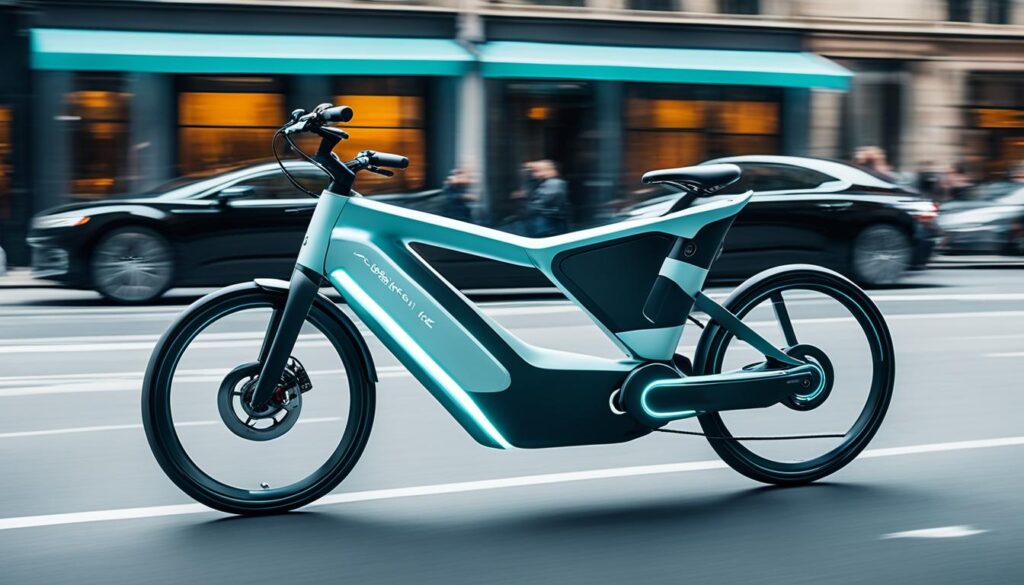The world of eco-friendly transportation is growing fast. Electric bikes, or e-bikes, are at the forefront of this movement. They combine the traditional pedaling experience with motorized help. When looking for an electric bike, consider its looks, how it performs, and its weight. Most electric bikes weigh between 30 to 80 pounds. This is because of the motor and battery, as well as the materials of the frame and parts.
Key Takeaways
- Electric bikes, commonly known as e-bikes, serve as a sustainable and efficient mode of transport, balancing pedal power with electric assistance.
- The weight of an electric bicycle is generally higher than that of a traditional bike, attributed to its motor and battery.
- Understanding the weight dynamics of e-bikes is vital for prospective buyers, especially considering ease of transportation and handling requirements.
- Weight considerations are not just about portability; they also influence an e-bike’s speed, range, and overall performance.
- Potential e-bike owners should account for the necessity of a robust bike rack if their chosen model is on the heavier side, often over 30 kilograms (about 66 pounds).
- Longevity and charging times of batteries play a role in maintaining the weight efficiency of electric bikes over time.
- The cost of an e-bike is variable, with average affordable models ranging from $1500 to $3000 and more advanced versions reaching beyond $12,000.
Decoding the Weight of an Electric Bike
Knowing why e-bikes are heavier is key for cyclists moving to electric bikes. E-bike weight matters a lot. It affects how the bike handles, its battery life, and what the ride feels like. Let’s look at why e-bikes are heavier and how they compare to regular bikes.
Comparing E-Bike Weight to Traditional Bicycles
When we talk about electric bike weight, there’s a big difference from traditional bicycles. E-bikes are heavier because of their tech and extra parts. These make pedaling easier. Compared to classic bikes, e-bikes can be two to three times heavier. This weight influences people thinking about getting an e-bike.
Components Contributing to E-Bike Mass
Different parts make e-bikes heavier than pedal bikes. These parts are crucial for e-bikes to work. But they also add weight. This makes a balance between functionality and heaviness.
| Component | Traditional Bicycle | Electric Bike | Approximate Additional Weight |
|---|---|---|---|
| Frame | Lightweight metals or composites | Reinforced to support additional components | 1-5 pounds |
| Motor | – | Hub or mid-drive | 6-12 pounds |
| Battery | – | Lithium-ion or lead-acid | 3-10 pounds |
| Drivetrain | Standard gearing system | Enhanced to accommodate motor torque | 1-4 pounds |
| Control Systems | – | Display, throttle, and sensor technology | 1-3 pounds |
The Impact of Electric Motors and Batteries on Weight
The main reason e-bikes are heavy comes from two parts: the battery weight and the electric motor weight. These make e-bikes much heavier than traditional bikes. But, they also give e-bikes their power and make them easy to ride.
Why Electric Bikes are Heavier: A Detailed Look at the Factors
When we look into factors affecting e-bike weight, it helps buyers understand the electric bike market better. The main reasons e-bikes are heavy include their motors and batteries. Motors, which help with the bike’s propulsion, weigh between 2 to 5 kilograms.
Batteries add quite a bit of weight too, coming in at 5 to 9 kilograms. They’re crucial for long rides and climbs. This is what makes electric bikes heavier compared to traditional bikes. Consider this: an electric bike’s average weight is between 20-25 kilograms. That’s almost twice as much as non-electric bikes.
The material and durability needed for e-bike frames also add weight. Frame weights can vary between 63.5 to 73 pounds. People choose lighter e-bikes for easier city riding. But, for rugged terrains and long trips, heavier e-bikes are better because they have more power and longer battery life.
But asking why e-bikes are heavy is not just about the weight. It’s about what you get from that weight. For example, Steve Volkers and Glen Mayenschein use their e-bikes in Washington D.C. They like the mix of an efficient commute and getting some exercise. And for those who love cycling, there’s a whole range of e-bikes to suit different needs.
You can find sleek electric road bikes for long distances or electric mountain bikes for rough terrains. There are also hybrid and cruiser bikes that offer both efficiency and comfort. Plus, the fat-tire and folding electric bikes are great for those who need versatility and easy storage.
- Commuter e-bikes: Ideal for everyday travel and combating traffic jams.
- Performance road bikes: Cater to long-distance cyclists seeking speed with assistance.
- Mountain e-bikes: Offer support for off-road adventures and challenging terrains.
- Hybrids and cruisers: Provide a blend of speed and comfort for leisurely rides.
- Fat-tire and folding bikes: Adapt to niche demands for versatility and portability.
The importance of factors affecting e-bike weight ties closely to their overall value. With over half of U.S. states recognizing them as bicycles and an ideal price point around $1,500, electric bikes stand out. They offer great performance and are a practical, accessible transport option economically.
Electric Bike Performance and the Weight Equation
E-bikes are changing the game by mixing old-school cycling with motor-powered travel. Their key feature is how power assists blend in with pedaling. Yet, the added weight from the battery, motor, and controller is important for e-bike performance, energy efficiency, and handling and maneuverability.
The Relationship Between Weight and Speed
When it comes to e-bikes, speed and weight are closely linked. Regular bikes are lighter, which means faster starts and easier climbs. E-bikes, however, are heavier. For instance, some Ride1Up models balance weight between thirty-three to sixty-five pounds. This added weight, especially from batteries, can make pedaling harder, especially uphill.
How Weight Influences Energy Efficiency and Range
The best thing about e-bikes is how far they go with little energy. But, a heavy battery and motor can shorten the trip. The latest e-bikes use lighter batteries and motors to save energy and go further. Companies like Fazua and Bosch work on making these parts lighter to boost distance and performance.
Handling and Maneuverability: The Weight Factor
E-bike handling and turning depend a lot on weight distribution. Some electric bikes are heavier on purpose for more stability in the city. But, lighter e-bikes excel in tough terrain or long rides. Folding bikes and fat tire models offer a good balance of handling and maneuverability. They use light yet strong materials like aluminum and carbon fiber for a better ride.
Overall, an e-bike’s weight affects many parts of its performance, from speed to how far it can go. But, makers are finding ways to keep bikes light and efficient. With new tech, we can expect e-bikes to get even better at saving energy and providing a great ride.
Choosing Your Electric Bike: Light vs. Heavy Frames
11% of Americans have tried an e-bike in the last year, mainly for fun. The choice between a light or heavy e-bike frame matters a lot. It’s influenced by many factors, including cost, performance, and material qualities. This decision will affect what e-bike suits your needs best.
Benefits of a Lighter Electric Bike
Light e-bike frames, like those made from aluminum or carbon fiber, stand out for being easy to handle. Because they’re lighter, you can move and carry them without much effort. Examples include the Aventon Ramblas eMTB at 56 lb and Co-op Cycles Generation e1.1 at 54 lb, offering both comfort and performance. Thanks to better batteries and motors, bikes like the Ride1Up Portola are light yet reliable, and cost only $995.
When is a Heavier Electric Bike Preferable?
But, there are times when a heavier e-bike is the better choice. For those who value stability and durability, a heavy frame is key. The Aventon Aventure.2 and Rad Power Bikes RadRover 6 Plus both weigh over 70 lb, making them great for off-road adventures or carrying loads. They often have disc brakes too, which provide reliable stopping power, adding to their safety.
Material Choices and Their Influence on Bike Weight
The material of the frame greatly affects both the bike’s weight and how it feels to ride. Aluminum offers a good balance of cost and performance, while carbon fiber is lighter and stronger but more expensive. These materials are found in many e-bike models, affecting their weight, performance, and price. Consumer Reports includes these factors in their evaluations.
When choosing between a light or heavy frame, don’t forget a test ride is crucial. Adjustable features like handlebars and seats make the ride more comfortable and fit better. With bicycle prices going down, now is a great time to find an e-bike that fits your style and budget. It’s key to understand the trade-offs between light and heavy e-bike frames.
Electric Bike
Urban commuting and fun cycling are changing fast, thanks to electric bike features. Electric bikes are the fastest-growing segment in cycling today. They come with better improved battery technology, stronger motors, and lighter frames. These improvements mean electric bikes offer more range, reliability, and fun. This change has brought about new electric bike kinds that appeal to all types of cyclists.
The market is now more favorable for buyers, with bike prices going down. This means great deals on many top electric bike models. Brands like Aventon, Ride1Up, and Lectric offer high-performing, affordable models. They compete with well-known names like Specialized and Trek, which have a wide range of e-bikes. REI’s Co-op e-bikes and others are also widely available in the U.S.
The Bicycling’s 2023 Bike Awards highlighted 12 outstanding e-bikes. Over half of U.S. trips are three miles or less, yet 72 percent use cars. Benefits of electric bikes could change this, making short trips easier and greener than using cars.
Experts believe electric bikes costing $1,000 to $2,000 offer good durability and quality. Micah Toll suggests $1,500 as the ideal balance between affordability and quality.
Types of electric bikes now include everyday commuter bikes, fat-tire and folding models, and specialty bikes. For instance, mountain bikes with electric motors are great for downhill thrills without hard climbs. Electric road bikes help with long-distance rides by reducing tiredness. Hybrid electric bikes offer efficient road performance and a comfy riding posture. Meanwhile, cruiser electric bikes focus on comfort and fun on all terrains, perfect for relaxed rides.
| Model | Weight | Power | Top Speed | Price |
|---|---|---|---|---|
| Aventon Level.2 | 60 lb. | 750W | 28 mph | Check Website |
| Co-op Cycles Generation e1.1 | 54 lb. | 350W | 20 mph | Check Website |
| Aventon Aventure.2 | 77 lb. | 750W | 28 mph | Check Website |
| Rad Power Bikes RadRover 6 Plus | 74 lb. | 750W | 20 mph | Check Website |
| Ride1Up Portola | – | – | – | $995 at ride1up.com |
Manufacturers cater to everyone by offering a range of e-bike models. This means both new and experienced riders can find an e-bike that suits their lifestyle and budget. All these electric bike features and benefits of electric bikes point to a future where more people use e-bikes daily. This switch can lead to a healthier, more eco-friendly, and fun way of getting around.
Conclusion
At the end of our discussion on e-bike weight, it’s crucial to think about what drives this industry forward. The e-bike market in Europe has seen a sharp rise. Sales went up by 9% in the Netherlands, 19% in Germany, and 30% in France in just 2017. Even though e-bikes are heavier than regular bikes, people still love them. This is clear with top models like the Specialized Vado.
In the Netherlands, e-bikes are used for longer commutes than traditional bikes by 50%. This shows how practical they are. The reasons behind the e-bike boom include market trends, consumer habits, and economic factors. For instance, tariffs on e-bikes made in China by the Trump administration have had an impact.
Studies like the Waterloo WeBike pilot, which lasted nearly three years, shed light on how people use e-bikes. They also show that users aren’t worried about battery life. Globally, over 200 million e-bikes are used in China alone. The e-bike market is expected to be worth USD 24.3 billion by 2025. This points to a healthy sector and quick shifts to electric transport by society.
In summary, an e-bike’s weight plays a complex role, influenced by tech advances and demand changes. We’ve seen how growth and acceptance have surged through data analysis. This indicates that despite their weight, e-bikes are pushing us toward greener, more effective ways to move around. As e-bikes break new ground in innovation, they become key to reshaping how we travel. They promise a future where being heavier means offering a richer, more powerful cycling experience.



